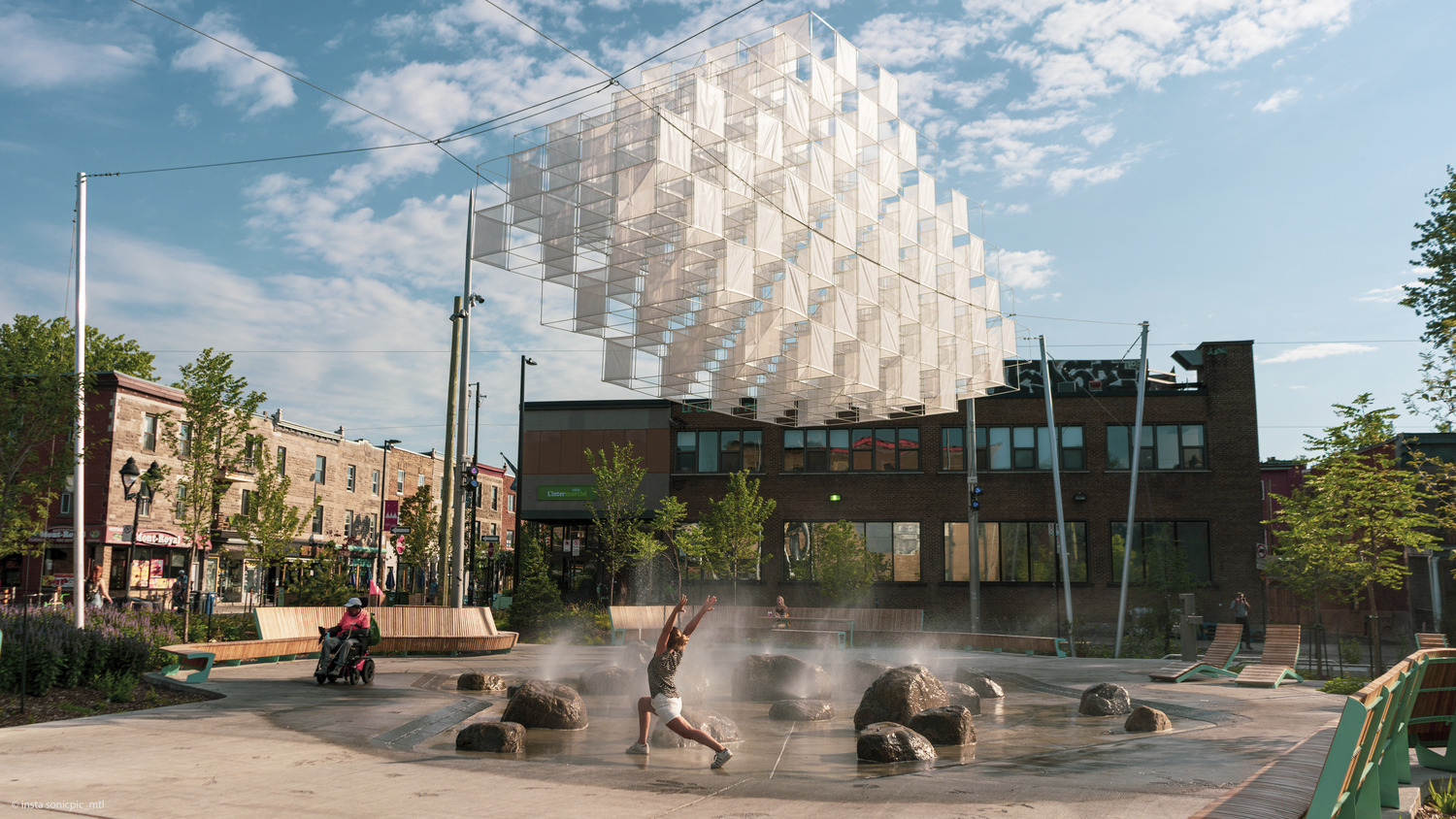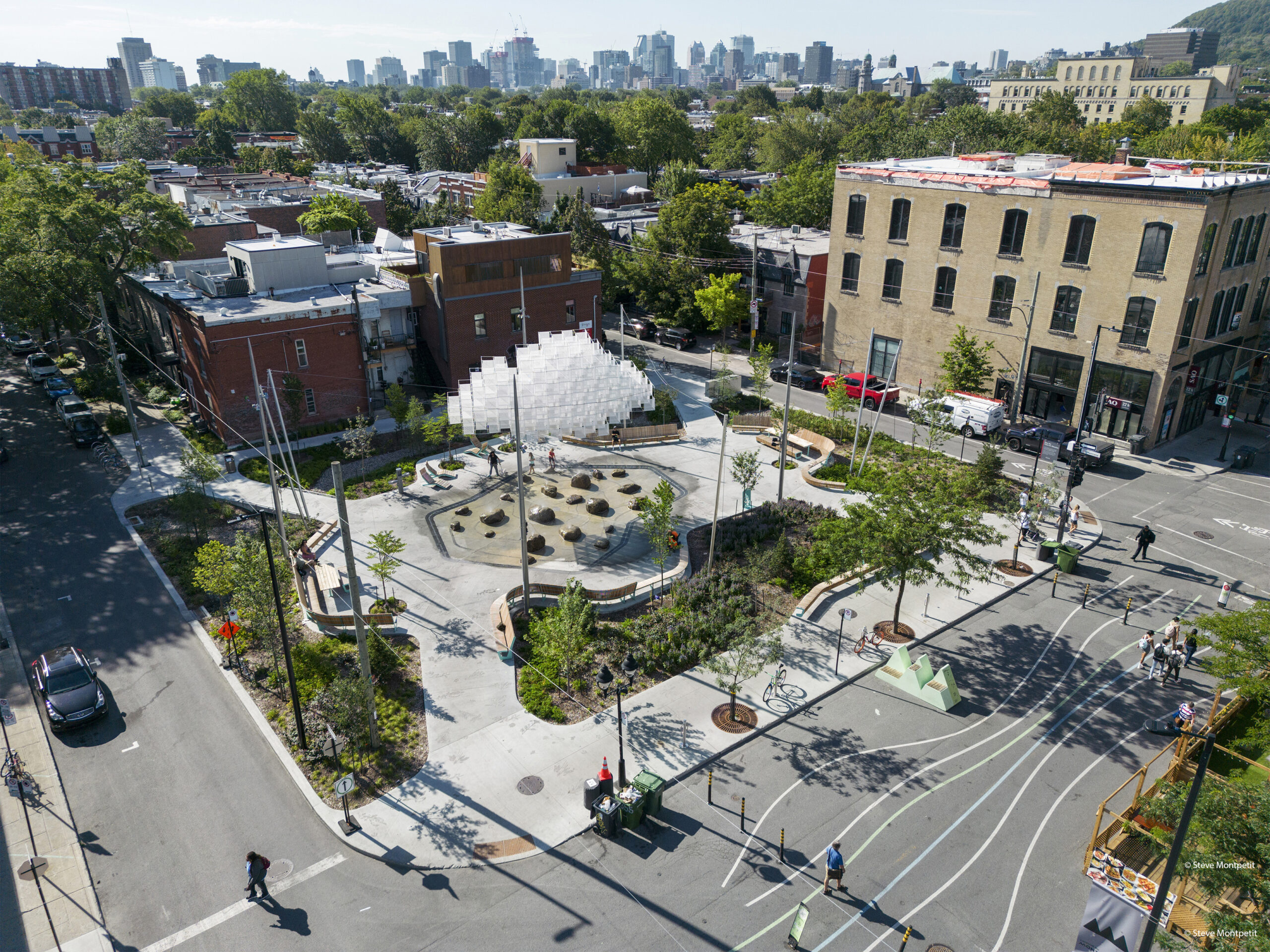By Alexandre Lynch, Project Manager, Urban Infrastructure | EXP
The rise in environmental effects associated with climate change and the corresponding impacts on communities require immediate attention. Extreme swings in weather conditions, such as severe precipitation and periods of drought, are a growing phenomenon and area of concern. To combat these issues, engineers are designing solutions tailored to changing weather conditions, like resilient parks. These parks help mitigate flooding and reduce urban heat islands, making cities more resilient to climate change impacts.
In urban areas, large amounts of rainfall can result in rapid runoff towards water infrastructure, potentially flooding the sewer system or receiving waterways, which have limited capacity. Most urban water management systems are combined systems, collecting both stormwater and wastewater. Unfortunately, this type of sewer system has been prioritized in urban development projects in the past. Today, due to the impacts of climate change, flooding is more likely to occur and cause costly and harmful damage. Excess water, containing pollutants such as organic waste or bacteria, may be discharged into receiving waterways without going through treatment processes. Because of these pollutants in waterways, protecting shorelines, plants and wildlife is critical during heavy rainfall events.
Drought periods have significantly increased, reducing the soil’s ability to absorb and filter stormwater. Urban areas already have a high density of impermeable mineral surfaces, making the situation even more critical. Green spaces need to have the ability to absorb enough water to promote plant growth to mitigate heat island effects. These challenges require targeted action, especially regarding water capacity in wastewater systems. City density consisting of housing, schools, parks, businesses and other urban infrastructure makes adding traditional systems such as underground reservoirs complex and costly, due to the lack of available space. It’s critical to develop innovative, sustainable solutions that are adapted to the effects of climate change to reduce the impacts on urban infrastructure, while increasing the resilience of cities.
Although severe rainfall and drought events are increasing, they are not a daily occurrence. To effectively manage investments and public spaces, municipalities are turning to multifunctional urban developments. These developments offer a resilient solution to environmental challenges while allowing residents to enjoy water management systems when they’re not performing their primary function. One of the most efficient methods to create a resilient development is the creation of resilient parks.
What is a resilient park?
Resilient parks are characterized by how stormwater is managed within a multi-purpose, temporarily floodable public space designed for water absorption and retention. When they’re not retaining rainwater, these spaces can serve a variety of purposes, ranging from a playground to an outdoor amphitheatre or sports field, allowing residents to enjoy the public space. The best water management approach varies depending on several factors specific to each municipality. For example, a public space with a bioretention basin could be built on a site that has soil with good infiltration capacity.
In addition to being generally less costly than traditional systems, resilient parks are easier to integrate into urban areas. This type of development is most effectively created under certain conditions, such as:
- A location with a high proportion of impermeable surfaces generating significant water runoff.
- A location with significant urban density requiring that available space be maximized.
- A high-traffic area to maximize use of the space by residents.
- A low-elevation location to facilitate water management.
- A location with relatively permeable soil and a sufficiently low water table.
- A location where the stormwater system is overloaded, allowing the effects of flooding to be mitigated.
- A location with a combined sewer system type.
- A location where construction is scheduled.
Where does the concept of resilient parks come from?
The first resilient park was designed in response to rising sea levels on the edge of Rotterdam in the Netherlands, where about 85% of the land is below sea level, making it particularly vulnerable to water level fluctuations and floods. Retention areas in Rotterdam became necessary to ensure safe and effective management of water runoff, which rose by a considerable 25% compared to the reference period of 1910 to 2009. Watersquare Benthemplein[1] was designed to mitigate the risks associated with the climate situation. Officially opened in 2013, this public space holds up to 1,700 cubic metres of water during heavy rainfall, and it allows water to be reused during periods of drought. When it’s not acting as a bioretention basin, the park is a recreation space where everyone community members can congregate.
In Quebec, the issue of stormwater management became more urgent around 2012, when cities and municipalities faced restrictions regarding the rate at which water could be discharged into the sewer systems, due to increased urban density and impermeable surfaces. That significant increase resulted in a flow rate that exceeded the absorption capacity of most urban infrastructure and receiving waterways. In addition to imposing rate limits, the Ministère de l’Environnement, de la Lutte contre les changements climatiques, de la Faune et des Parcs issued the Guide de gestion des eaux pluviales, encouraging municipalities to look into alternative methods, focusing on quality water management rather than single-use underground drainage systems. As a result, water management solutions began to be reviewed to adapt them to the new situation.
Quebec’s first sponge park built in Montreal
A 2017 report by ‘the Commission permanente sur l’eau, l’environnement, le développement durable et les grands parcs’ recommended the development of a resilient park in Montreal. Following this report, the Place des Fleurs-de-Macadam site was selected to host the first pilot project in Quebec for a water management space in a public square. In collaboration with landscape architecture firm NIPPAYSAGE, EXP designed the plans and specifications, as well as oversaw the construction of the project.
When designing a water management project that integrates a resilient park into a municipality, it’s essential to define the roles and responsibilities of each stakeholder, set performance criteria, plan the structure criteria and constraints and conduct preliminary studies. EXP provided geotechnical and environmental studies, permeability studies, land surveys, 3D grading simulations and hydraulic behaviour simulations. Place des Fleurs-de-Macadam was designed to provide residents with an urban space where they can fully enjoy the City of Montreal’s investments in stormwater management, through urban developments that encourage people of all ages to relax, have fun and spend time together. Street furniture and a basin with water misters allow people to cool down during the summer months in a welcoming space. Developing the site led to the revitalization of a public space in the area, mitigating the urban heat island effect and greening the neighborhood, while providing a place where pedestrians on Mont-Royal Avenue can relax and enjoy the park. Located on the site of a former gas station, Place des Fleurs-de-Macadam is an important resource and attraction in the heart of Montreal, rooted in cultural, environmental and social values.
The public square collects stormwater from adjacent streets and transfers it to the central area. Using a bioretention basin and phytotechnology, the water is collected, filtered and treated. The park’s main objective is to achieve total infiltration of runoff based on a 25-year rainfall index. EXP’s proposed design aims to exceed infiltration targets, as simulations carried out using the proposed model showed that the project exceeds expectations and will allow total infiltration of stormwater up to a 100-year rainfall event. Tests carried out by the City of Montreal and the Institut national de la recherche scientifique (INRS) confirmed the performance level of the facilities.
When the park officially opened in spring 2022, residents were quick to start using the space. During periods of intense rainfall, pedestrians can observe how water flows through the site, and they are able observe how effective the resilient park’s innovative infrastructure is. The park continues to attract attention during heavy rainfall and during heat waves when residents can cool off using the water misters.

The critical role of green infrastructure
The success of Place des Fleurs-de-Macadam has been instrumental in the development of additional resilient parks in response to climate change, with numerous examples across the province, including Dickie-Moore Park and Howard Park. Although this project was the first of its kind in Quebec, EXP has contributed to green infrastructure design for a long time. EXP’s global expertise has been leveraged in a variety of projects that have helped reduce the impacts of climate change on urban infrastructure and increase the resilience of cities.
As part of the redevelopment of the former Currie brownfield site in Calgary, EXP’s multidisciplinary teams were involved in developing resilient urban infrastructure aimed at creating a sustainable living environment. The project’s core features include bioretention basins and gardens designed with more permeable soils to facilitate the infiltration and treatment of excess water during precipitation periods. The variety of plants used, which plays a key role in green infrastructure, replicate the function of natural retention spaces, which are often less present in urban areas because of limited space.
In Montreal, the Papineau Avenue redevelopment project also uses that approach. The integration of 38 bioretention basins and vegetated basins over approximately 1.2 km has turned this section of road into a green space, while also reducing pressure on the existing sewer system. As with the Currie Streetscapes Project in Calgary, EXP experts used a wide variety of plants to facilitate infiltration and stormwater treatment. The development treats approximately 10,000 cubic metres of stormwater per year and removes 80% of suspended solids from the treated water because of the 40,000 plants growing on the site.
Our engineers and landscape architects take great pride in designing public spaces with sustainable solutions that mitigate the effects of climate change and allow residents to enjoy urban life to the fullest. To learn more about our stormwater management services, contact Alexandre Lynch, Project Manager, Urban Infrastructure.
[1] De Urbanisten (Watersquare Benthemplein, Rotterdam — DE URBANISTEN)

